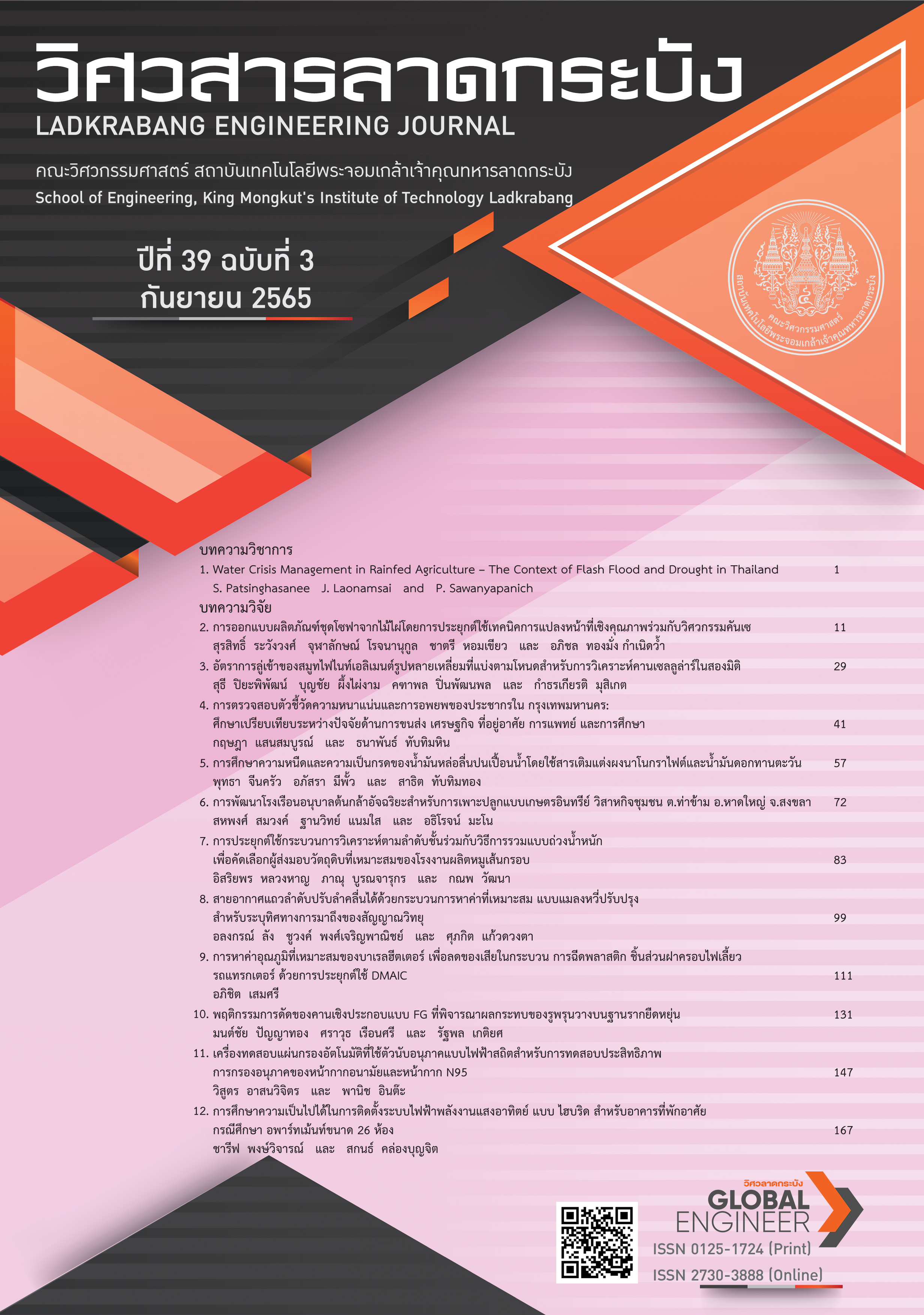Development of Smart Seedling Nursery for Organic Cultivation Community Enterprise, Tha Kham Subdistrict, Hat Yai District, Songkhla
Keywords:
Smart seedling nursery, Environment control system, Organic farming, Solar systemAbstract
This research is the development of smart seedling nursery for organic cultivation. It is used to increase the efficiency of seedling nursery and increase the strength and fertility of seedlings before they are transplanted into large plots of the community enterprise group, Tha Kham Subdistrict, Hat Yai District, Songkhla Province. This smart seedling nursery greenhouse controls the following factors affecting seedling growth: the temperature inside is in the range of 25–30°C, the relative humidity is in the range of 65–90%, soil moisture is moderate (50–70%). This smart seedling nursery has a misting system and a ventilation system that helps to adjust the environment to the specified range at all times. In addition, it also uses light from 430–630 nm LED Grow light at night. It helps seedlings to photosynthesize for an additional 5 hours in the absence of sunlight. This smart seedling nursery can accommodate up to 12 trays of 200 holes seedling trays. From the test of nursery of green oak seedlings in the smart seedling nursery greenhouses for 6 days compared to the original method. It was found that the seedlings were fertile, strong, and growing faster. The length of the trunk was 16.9% greater than the original method. It can reduce the time of nursery seedlings before planting a large plot by about 33%. Importantly, if seedlings are reared at full efficiency, this smart greenhouse will be able to reduce the area used by about three times that of the traditional nursery of community enterprises.
References
C. Lozoya, E. Eyzaguirre, J. Espinoza, S. L. Montes-Fonseca and G. Rosas-Perez, “Spectral Vegetation Index Sensor Evaluation for Greenhouse Precision Agriculture,” in 2019 IEEE SENSORS, Montrea, Canada, 2019, pp. 1–4, doi:10.1109/SENSORS43011.2019.8956911.
T. Pobkrut, T. Eamsa-ard and T. Kerdcharoen, “Sensor drone for aerial odor mapping for agriculture and security services,” in 2016 13th International Conference on Electrical Engineering/Electronics, Computer, Telecommunications and Information Technology (ECTI-CON), Chiang Mai, Thailand, 2016, pp. 1–5, doi:10.1109/ECTICon.2016.7561340.
T. M. Bandara, W. Mudiyanselage and M. Raza, “Smart farm and monitoring system for measuring the Environmental condition using wireless sensor network - IOT Technology in farming,” in 2020 5th International Conference on Innovative Technologies in Intelligent Systems and Industrial Applications (CITISIA), Sydney, Australia, 2020, pp. 1–7, doi: 10.1109/CITISIA50690.2020.9371830.
L. Dan, C. Xin, H. Chongwei and J. Liangliang, “Intelligent Agriculture Greenhouse Environment Monitoring System Based on IOT Technology,” in 2015 International Conference on Intelligent Transportation, Big Data and Smart City, Halong Bay, Vietnam, 2015 pp. 487–490, doi: 10.1109/ICITBS.2015.126.
S. Vatari, A. Bakshi and T. Thakur, “Green house by using IOT and cloud computing,” in 2016 IEEE International Conference on Recent Trends in Electronics, Information & Communication Technology (RTEICT), Bangalore, India, 2016, pp. 246–250, doi: 10.1109/RTEICT.2016.7807821.
P. Unkaw, “Automatic Nutrient Solution Control System for Planting Hydroponics Vegetables with Internet of Things (IoT),” RMUTSVRJ Research Journal, vol. 11, no. 1, pp. 146–157, 2019.
A. Chaoumead, and D. Phangkeio, “Soil Moisture Control System for Melon Cultivation in Greenhouse,” RMUTSVRJ Research Journal, vol. 11, no. 2, pp. 269–278, 2019.
T. Kaewwiset and P. Yodkhad, “Automatic temperature and humidity control system by using Fuzzy Logic algorithm for mushroom nursery,” in 2017 International Conference on Digital Arts, Media and Technology (ICDAMT), Chiang Mai, Thailand, 2017, pp. 396–399, doi: 10.1109/ICDAMT.2017.7905000.
M. Mehra, S. Saxena, S. Sankaranarayanan, R. J. Tom and M. Veeramanikandan, “IoT based hydroponics system using Deep Neural Networks,” Computers and Electronics in Agriculture, vol. 155, pp. 473–486, 2018, doi: 10.1016/j.compag.2018.10.015.
K. -H. Lin, M. -Y. Huang, W. -D. Huang, M. -H. Hsu, Z. -W. Yang and C. -M. Yang, “The effects of red, blue, and white light-emitting diodes on the growth, development, and edible quality if hydroponically grown lettuce,” Scientia Horticulture, vol. 150, pp. 86–91, 2013, doi: 10.1016/j.scienta.2012.10.002.
H. Li, C. Tang, Z. Xu, X. Liu and X. Han, “Effects of different light sources on the growth of non-heading chinese cabbage (Brassica campestris L.),” Journal of Agricultural Science, vol. 4, no. 4, pp. 262–273, 2012, doi: 10.5539/jas.v4n4p262.
P. Limprasitwong and C. Thongchaisuratkrul, “Plant Growth Using Automatic Control System under LED, Grow, and Natural Light,” in 2018 5th International Conference on Advanced Informatics: Concept Theory and Applications (ICAICTA), Krabi, Thailand, 2018, pp. 192–195, doi: 10.1109/ICAICTA.2018.8541308.
P. Yuda, P. A. Gautama, R. Andrian, “Evaluation of IoT-Based Grow Light Automation on Hydroponic Plant Growth,” Journal Ilmiah Teknik Elektro Komputer dan Informatika (JITEKI), vol. 7, no. 2, pp. 314–325, 2021, doi: 10.26555/jiteki.v7i2.21424.
S. Sahapong and C. Mitchai, “Development of an environmental control system for growing microgreens,” FEAT Journal, vol. 5, no. 2, pp. 15-25, 2019.
Downloads
Published
How to Cite
Issue
Section
License
Copyright (c) 2022 Faculty of Engineering, King Mongkut’s Institute of Technology Ladkrabang

This work is licensed under a Creative Commons Attribution-NonCommercial-NoDerivatives 4.0 International License.
The published articles are copyrighted by the School of Engineering, King Mongkut's Institute of Technology Ladkrabang.
The statements contained in each article in this academic journal are the personal opinions of each author and are not related to King Mongkut's Institute of Technology Ladkrabang and other faculty members in the institute.
Responsibility for all elements of each article belongs to each author; If there are any mistakes, each author is solely responsible for his own articles.






